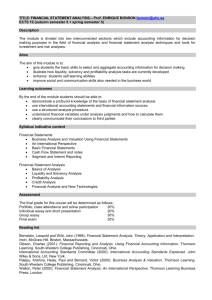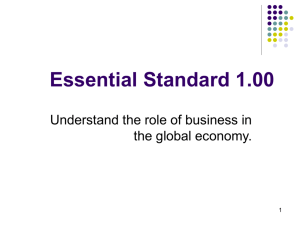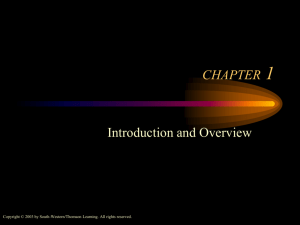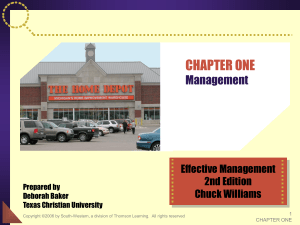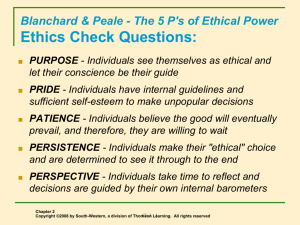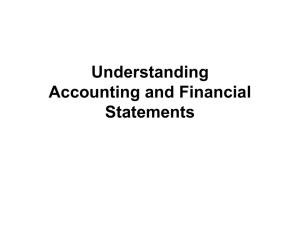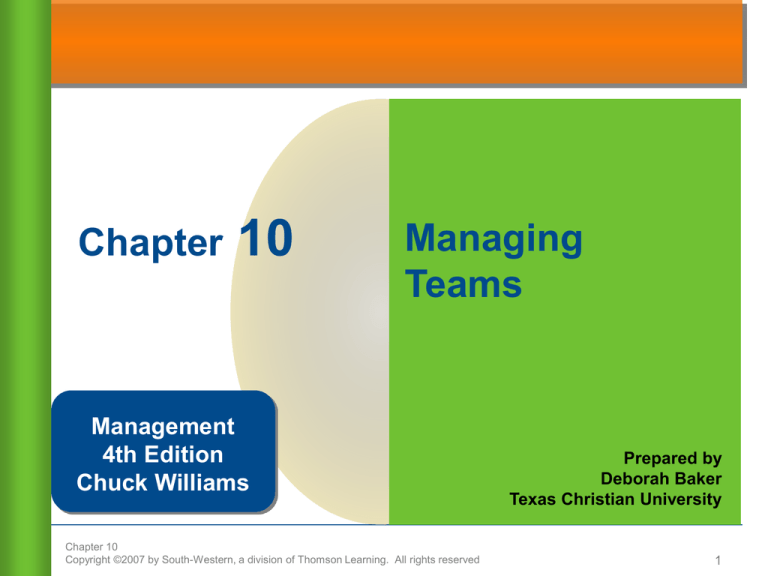
Chapter
10
Managing
Teams
Management
4th Edition
Chuck Williams
Chapter 10
Copyright ©2007 by South-Western, a division of Thomson Learning. All rights reserved
Prepared by
Deborah Baker
Texas Christian University
1
What Would You Do?
Standard Motor Products, Edwardsville, Kansas.
Standard Motor Products makes
aftermarket auto parts
The auto parts market is growing,
but it is very competitive—
and Standard Motor Products is
struggling. Downtime is up, productivity
is down, and costs are up.
The culture is top-down and authoritarian
and the workers dislike each other
Would the use of teams resolve the problems? If
so, how should teams be paid and managed?
Chapter 10
Copyright ©2007 by South-Western, a division of Thomson Learning. All rights reserved
2
Why Work Teams?
After reading these sections,
you should be able to:
1.
2.
explain the good and bad of using teams.
recognize and understand the different kinds of
teams.
Chapter 10
Copyright ©2007 by South-Western, a division of Thomson Learning. All rights reserved
3
The Good and Bad of Using Teams
Advantages
of Teams
Disadvantages
of Teams
When to Use
And
Not Use Teams
1
Chapter 10
Copyright ©2007 by South-Western, a division of Thomson Learning. All rights reserved
4
The Advantages of Teams
Customer Satisfaction
Product and Service Quality
Speed and Efficiency in Product Development
Employee Job Satisfaction
Decision Making
Multiple perspectives
1.1
More alternate solutions
Commitment to decisions
Chapter 10
Copyright ©2007 by South-Western, a division of Thomson Learning. All rights reserved
5
The Disadvantages of Teams
Initially High Employee Turnover
Social Loafing
Disadvantages of
Group Decision Making
Groupthink
Minority domination
Inefficient meetings
Lack of accountability
1.2
Chapter 10
Copyright ©2007 by South-Western, a division of Thomson Learning. All rights reserved
6
Doing the Right Thing
Don’t be a Team Slacker—Do Your Share
Slacking on teams is wrong
Slacking hurts a team’s performance
In the real world, team slacking contributes to
lost sales, poorer decisions, lower-quality products,
and lower productivity
1.2
Chapter 10
Copyright ©2007 by South-Western, a division of Thomson Learning. All rights reserved
7
The Disadvantages of Teams
Factors that Encourage People
to Withhold Effort in Teams
1.
The presence of someone with expertise
2.
The presentation of a compelling argument
3.
Lacking confidence in one’s ability to contribute
4.
An unimportant or meaningless decision
5.
A dysfunctional decision-making climate
1.2
Chapter 10
Copyright ©2007 by South-Western, a division of Thomson Learning. All rights reserved
Adapted From Exhibit 10.2
8
When to Use Teams
USE TEAMS WHEN…
DON’T USE TEAMS WHEN…
There is a clear purpose
There is no clear purpose
The job can’t be done
unless people work
together
The job can be done
independently
Team-based rewards
are possible
Only individual-based
rewards exist
Ample resources exist
Resources are scarce
Teams have authority
Management controls
1.3
Chapter 10
Copyright ©2007 by South-Western, a division of Thomson Learning. All rights reserved
Adapted From Exhibit 10.3
9
Kinds of Teams
How Teams
Differ in
Autonomy
Special Kinds
Of
Teams
2
Chapter 10
Copyright ©2007 by South-Western, a division of Thomson Learning. All rights reserved
10
Autonomy, the Key Dimension
Employee
Involvement
Teams
Traditional
Work
Groups
Semiautonomous
Work
Groups
Selfmanaging
Teams
Selfdesigning
Teams
Autonomy
2.1
Chapter 10
Copyright ©2007 by South-Western, a division of Thomson Learning. All rights reserved
Adapted From Exhibit 10.4
11
Special Kinds of Teams
Cross-Functional
Teams
Virtual
Teams
Project
Teams
2.2
Chapter 10
Copyright ©2007 by South-Western, a division of Thomson Learning. All rights reserved
12
Cross-Functional Teams
Employees from different
functional areas
Attack problems from multiple
perspectives
Generate more ideas and
alternative solutions
Often used in conjunction with
matrix and product
organizational structures
2.2
Chapter 10
Copyright ©2007 by South-Western, a division of Thomson Learning. All rights reserved
13
Virtual Teams
Tips for Managing
Successful Virtual Teams
2.2
Select self-starters and strong communicators
Empower virtual teams
Keep the team focused on clear, specific goals
Provide frequent feedback
Keep team upbeat and action-oriented
Periodically bring team members together
Improve communications
Ask team members for feedback on how well
team is working
Chapter 10
Copyright ©2007 by South-Western, a division of Thomson Learning. All rights reserved
Adapted From Exhibit 10.5
14
Project Teams
Created to complete specific, one-time projects
within a limited time
Often used to develop new products, improve
existing products, roll out new information
systems, or build new factories/offices
Can reduce or eliminate
communication barriers,
and speed up the
design process
Promote flexibility
2.2
Chapter 10
Copyright ©2007 by South-Western, a division of Thomson Learning. All rights reserved
15
Managing Work Teams
After reading these sections,
you should be able to:
3.
understand the general characteristics of
work teams.
4.
explain how to enhance work team
effectiveness.
Chapter 10
Copyright ©2007 by South-Western, a division of Thomson Learning. All rights reserved
16
Work Team Characteristics
Team
Norms
Team
Size
Team
Cohesiveness
Team
Conflict
Team
Development
3
Chapter 10
Copyright ©2007 by South-Western, a division of Thomson Learning. All rights reserved
17
Team Norms
Informally agreed-on standards that regulate
team behavior
Powerful influence on work behavior
Regulate the everyday behaviors of teams
3.1
Chapter 10
Copyright ©2007 by South-Western, a division of Thomson Learning. All rights reserved
18
Team Cohesiveness
The extent to which members are attracted to the
team and motivated to remain in it
Cohesive teams:
retain their members
promote cooperation
have high levels of
performance
3.2
Chapter 10
Copyright ©2007 by South-Western, a division of Thomson Learning. All rights reserved
19
Promoting Team Cohesiveness
1.
Make sure all team members are present at team
meetings
2.
Create additional opportunities for teammates to
work together
3.
4.
Engage in nonwork activities as a team
Make employees feel that they are part of a
“special” organization
3.2
Chapter 10
Copyright ©2007 by South-Western, a division of Thomson Learning. All rights reserved
20
What Really Works
Cohesion and Team Performance
Team Performance
10% 20% 30% 40% 50% 60% 70% 80% 90% 100%
probability of success
66%
Team Performance with Interdependent Tasks
10% 20% 30% 40% 50% 60% 70% 80% 90% 100%
probability of success
73%
Team Performance with Independent Tasks
10% 20% 30% 40% 50% 60% 70% 80% 90% 100%
3.2
probability of success
60%
Chapter 10
Copyright ©2007 by South-Western, a division of Thomson Learning. All rights reserved
21
Performance
Team Size
Size
3.3
Chapter 10
Copyright ©2007 by South-Western, a division of Thomson Learning. All rights reserved
22
Team Conflict
C-type Conflict
cognitive conflict
focuses on problems and issues
associated with improvements in team
performance
A-type Conflict
affective conflict
emotional, personal disagreements
associated with decreases in team
performance
3.4
Both types often occur simultaneously
Chapter 10
Copyright ©2007 by South-Western, a division of Thomson Learning. All rights reserved
23
How Teams Can Have a Good Fight
1.
2.
3.
4.
5.
6.
Work with more, rather than less, information
Develop multiple alternatives to enrich debate
Establish common goals
Inject humor into the workplace
Maintain a balance of power
Resolve issues without forcing
a consensus
3.4
Chapter 10
Copyright ©2007 by South-Western, a division of Thomson Learning. All rights reserved
Adapted from Exhibit 10.6
24
Team Performance
Stages of Team Development
3.5
Performing
Norming
De-Norming
De-Storming
Storming
De-Forming
Forming
Time
Chapter 10
Copyright ©2007 by South-Western, a division of Thomson Learning. All rights reserved
Adapted from Exhibit 110.7
25
Enhancing Work
Team Effectiveness
Setting
Team Goals and
Priorities
Team
Training
Selecting
Team Members
Team
Compensation
4
Chapter 10
Copyright ©2007 by South-Western, a division of Thomson Learning. All rights reserved
26
Setting Team Goals and Priorities
Team goals enhance
team performance
Goals clarify team priorities
Challenging team goals help
team members to regulate effort
4.1
Chapter 10
Copyright ©2007 by South-Western, a division of Thomson Learning. All rights reserved
27
Requirements for Stretch Goals
to Motivate Team Performance
Teams have a high degree of autonomy
Teams are empowered with control resources
Teams need for structural accommodation
Teams need bureaucratic immunity
4.1
Chapter 10
Copyright ©2007 by South-Western, a division of Thomson Learning. All rights reserved
28
Selecting People for Teamwork
IndividualismCollectivism
Team
Level
Team
Diversity
4.2
Chapter 10
Copyright ©2007 by South-Western, a division of Thomson Learning. All rights reserved
29
Team Training
Interpersonal Skills
Decision Making
and Problem Solving
Conflict
Technical Training
Training for Team Leaders
4.3
Chapter 10
Copyright ©2007 by South-Western, a division of Thomson Learning. All rights reserved
30
Problems Reported by Team Leaders
1. Confusion about new roles
2. Feeling they’ve lost control
3. Not knowing what it means to coach or empower
4. Having doubts about whether team concept will work
5. Uncertainty about dealing with employees’ doubts
6. Confusion about when team is ready for more responsibility
7. Confusion about how to share responsibility and accountability
8. Concern about promotional opportunities
9. Uncertainty about the strategic aspects of leader’s role
as team matures
4.3 10. Not knowing where to turn for help with team problems
Chapter 10
Adapted
Copyright ©2007 by South-Western, a division of Thomson Learning. All rights reserved
from Exhibit 10.9
31
Team Compensation and Recognition
The level of reward must match the level of
performance
Three methods of compensating team
participants:
skill-based pay
gainsharing
nonfinancial rewards
4.4
Chapter 10
Copyright ©2007 by South-Western, a division of Thomson Learning. All rights reserved
32
Team Compensation and Recognition
4.4
Chapter 10
Copyright ©2007 by South-Western, a division of Thomson Learning. All rights reserved
Exhibit 10.10
33


